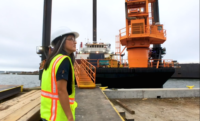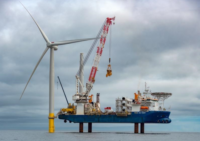China Three Gorges Corp. and partner Goldwind said Nov. 25 that they have built the largest offshore wind turbine, a 16-MW unit produced in China’s Fujian Province, with a 146-meter turbine hub and a 252-m dia. rotor that generates 34.2 kWh of power in a full rotating turn.
“China's wind turbine manufacturing has led the globe after the leap-forward development,” Lei Mingshan, chairman of China Three Gorges, said in a statement.
Goldwind says Chinese turbine manufacturers are now exceeding units produced by other industry leads GE, Siemens Gamesa and Vestas.
MingYang, another Chinese developer, also said it plans to roll out a 16-MW turbine. The company is China’s private wind turbine manufacturer and its planned overseas expansion could drive turbine sizes higher and wind farm development prices lower, the U.S. Institute for Energy Economics and Financial Analysis said in a report.
Mwanwhile, Chinese shipbuilder CSSC Haizhuang said Nov. 29 that it would unveil an 18-MW unit in mid-December, surpassing its rival Chinese developers as well as the European and U.S. manufacturers. The unit is said to have a 260-m rotor.
Eastern Europe
14.5
Gigawatts of global wind and solar power procured by top corporate buyers Amazon, Microsoft and Meta in 2021
—BloombergNEF
Big Boost Seen In Czech Nuclear Power
Bechtel confirmed Nov. 30 that it submitted a proposal with Westinghouse to build a new AP1000 nuclear unit in the Czech Republic with the possibility of building three more reactors.
France’s EDF and South Korea’s KHNP also submitted proposals by the Nov. 30 deadline for the project to be built at Dukovany, the Czech utility CEZ said.
Initial bids are the basis for clarifying technical and commercial parameters, and will now be analyzed with negotiations to follow with bidders, the utility said.
Final bids are due at the end of September 2023, Tomáš Pleskač, director of the ČEZ new energy division said in a statement. Contracts should be finalized in 2024, he saidm with construction of the 1,200 MW until completed in 2036.
The company plans a second unit at Dukovany and two units at Temelin to replace Soviet designed units, which will be decommissioned.
CEZ excluded bidders from China and Russia on security grounds.
Poland Commits to First Nuclear Fleet
The Polish government also selected Westinghouse’s AP1000 to build the country’s nuclear fleet, which is set to include up to nine units. The country does not now have nuclear power.
Work will start with three units at a site in northern Poland and potentially add three more there. Construction of the first unit will begin in 2026 with subsequent units built every two or three years, a government resolution approving the projects said.
Westinghouse signed memoranda of understanding with 22 companies in Poland for cooperation in construction of AP1000 reactors there and at other potential projects in Central Europe, the company said.
The US firm also has committed to establishing a major engineering center in Poland and is planning various additional industrial investments to support training and development of a nuclear power workforce. It plans to use both U.S. and European supply chains to build a fleet of AP1000 reactors in the region.
The deployment of AP1000 technology in Poland will drive greater regional synergy that benefits the Czech nuclear program, Westinghouse said.
The company also has four reactors under construction in China and two more are planned, it said. “Nine units have been announced for Ukraine, and the technology is under consideration at multiple other sites in Central and Eastern Europe, the UK and ithe US,” Westinghouse said.
Hungary Picks Russia for $12B Nuke Build
Hungary also will build two nuclear units, but it chose Russian state-owned Rosatom in August for the project, with construction set to begin soon and units operational by 2030, Foreign Minister Peter Szijjarto said.
They will be located in the central part of the country and expected to cost $12.4 billion. Russia will finance $10 billion, media reports said.
Russia's nuclear industry was not included in EU sanctions over the country’s invasion of Ukraine, but in May, Finland cancelled a project using Russian technology because of the invasion.






Post a comment to this article
Report Abusive Comment